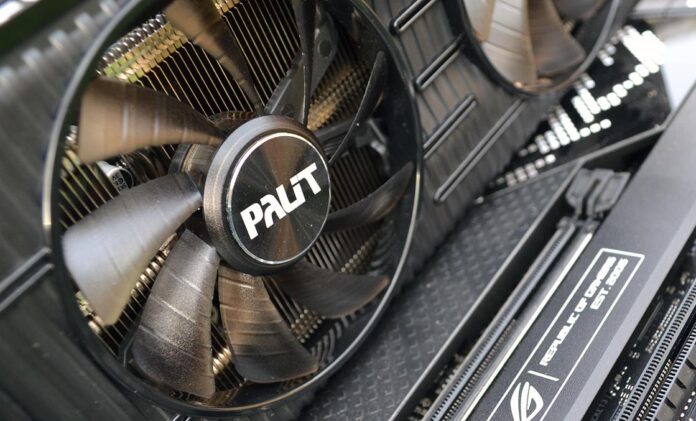Rival AMD came in for stick when it was uncovered that the Radeon RX 6500 XT graphics card used a PCIe 4.0 x4 interface allied to a measly 4GB framebuffer. This combination doesn’t do the card any favours as any textures that exceed the framebuffer are loaded over the PCIe bus. No real problem on cutting-edge motherboards sporting the latest PCIe 4.0 (and 5.0) connectivity, but certainly more of an issue for the millions of users toting PCIe 3.0-based motherboards. For them, unfortunately, bandwidth restrictions cause framerate to drop by an unacceptable degree.
Nvidia doesn’t make the same framebuffer mistake with GeForce RTX 3050. The 8GB capacity and 14Gbps transfer speed speaks to a sensible outlook if predominantly gaming at a FHD resolution, yet even Team Green isn’t completely without sacrifice. In the name of cutting complexity, cost and potentially increasing long-term supply, RTX 3050 uses a PCIe 4.0 x8 interface, which naturally relaxes down to PCIe 3.0 x8 for legion older systems.
As an aside, speaking of cost, it wouldn’t surprise us one iota if at some point in the near future Nvidia transitions desktop RTX 3050 to the smaller, cheaper-to-produce GA107 die used for laptop RTX 3050 and Ti GPUs – one that can also carry 2,560 shaders alongside the remainder of the desktop specification.
Our test systems are built to extract the most of each iterative technology, so we benchmark with a platform capable of PCIe 4.0, as shown in the launch-day review. It is, however, worth examining the effects, if any, of running RTX 3050 at PCIe 3.0 x8 speeds. For our motherboard it’s a simple case of switching out to Gen 3 connectivity in the BIOS. Doing so lets us mimic performance of older boards that cannot run the latest protocol standards.
Without further ado, let’s present the numbers!

The simplest method of discerning the actual bandwidth capability of the card(s) is to run the 3DMark PCIe Feature Test. As wholly expected, PCIe 4.0 x8 offers double the bandwidth of PCIe 3.0 x8, and the numbers infer the quoted interface width of eight lanes is indeed correct.


Carrying on the Futuremark theme, the first two test shows there to be practically no difference between running the Palit GeForce RTX 3050 Dual OC at either PCIe 4.0 x8 or 3.0 x8 speeds. In fact, the card is a mite faster when using the lower-bandwidth protocol; we put this down to the natural variations that exist from run to run.
Verdict: no meaningful difference.


Real-world games are a different beast. Using Very High Quality settings puts more onus on the subsystem to load textures and attendant data quickly. We see a slight drop solely from changing the PCIe protocol. Not enough to be noticeable but consistent nonetheless.
Verdict: a small gain for PCIe 4.0 x8.


There is no two ways about it. Reducing the PCIe bandwidth does have implications for gaming. They aren’t huge, of course, and we’d challenge anyone to spot the difference when gaming.
Verdict: you’d need to overclock the PCIe 3.0-riding card quite a bit to match default PCIe 4.0 performance.


Games that are generally easier on the graphics card – read higher average framerates – don’t tend to need a fast interface between host computer and graphics card.
Verdict: no meaningful difference in this title.


Nothing really in it as far as Forza Horizon 4 is concerned. A sign of a well-coded game whose working set fits neatly into an 8GB framebuffer.
Verdict: Nought to see here.


A minor reduction at QHD is a small price to pay. PCIe bandwidth has little effect in Gears Tactics.
Verdict: No need for PCIe 4.0 in this game.


Set to High for image quality, the largest differences to date are in the beautiful-looking God of War. There’s a repeatable seven per cent reduction at FHD when moving down to PCIe 3.0 x8 on the very same platform, whilst the drop-off, for some reason, isn’t quite as severe at QHD.
Nevertheless, the gaps produced solely by PCIe speeds are significant.
Verdict: You’d definitely want to be swinging Kratos’ axe using PCIe 4.0 x8 connectivity.
Final Thoughts
Placing the GeForce RTX 3050 into a motherboard only capable of PCIe 3.0 card-to-chipset connectivity doesn’t replicate the horror show present on Radeon RX 6500 XT.
There are instances where having only half the traditional bandwidth is a performance bugbear, most notably in games that move lots of textures around, and the exact deterioration can only be made on a case-by-case basis. Even so, the maximum deficit is around seven per cent, which while not ideal, doesn’t fundamentally alter the games-playing experience.
Recent trends of limiting the PCIe bandwidth on mainstream cards speaks to ongoing production issues, and Nvidia chooses PCIe 4.0 x8 to make available more supply than would otherwise be the case. It’s nigh-on impossible to verify these supply-related claims, but for most gamers out there using older motherboards, do appreciate that upgrading to a PCIe 4.0 platform offers free performance boosts in some notable games.
This scaling snafu becomes less of a concern as time drives further adoption of new platforms, but for now, it’s certainly advisable to consider a new graphics card alongside a fresh hardware build.


